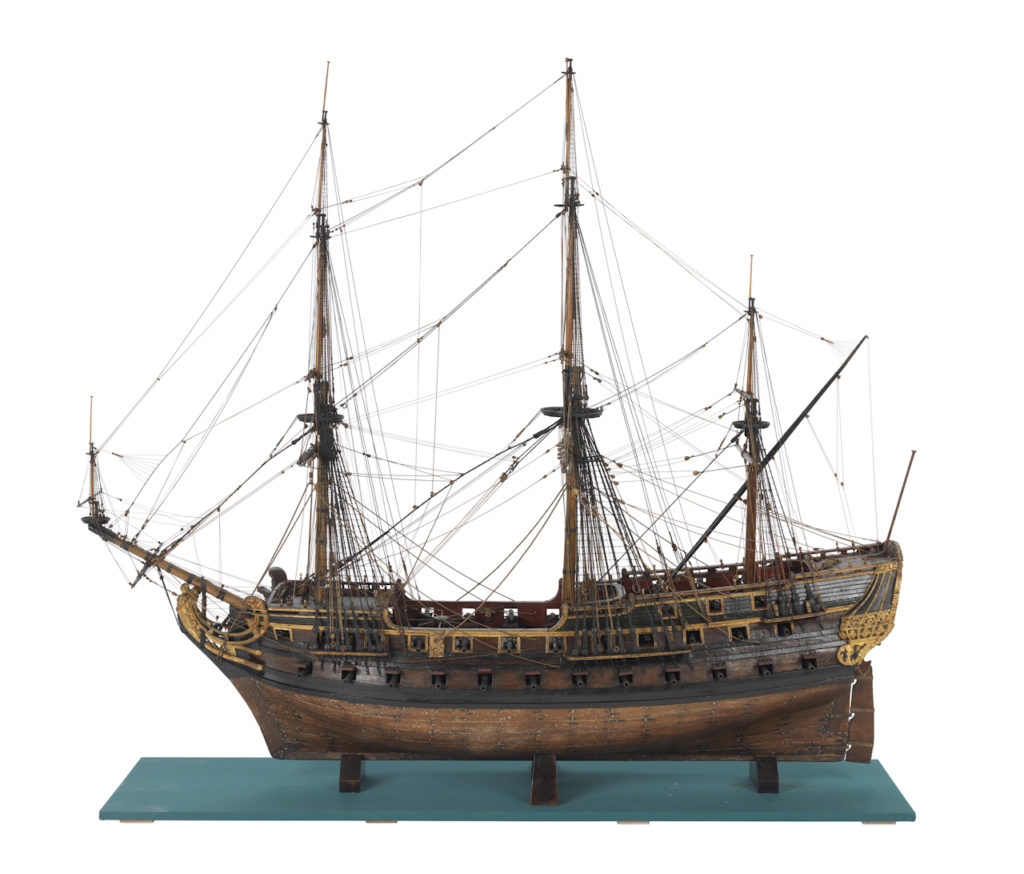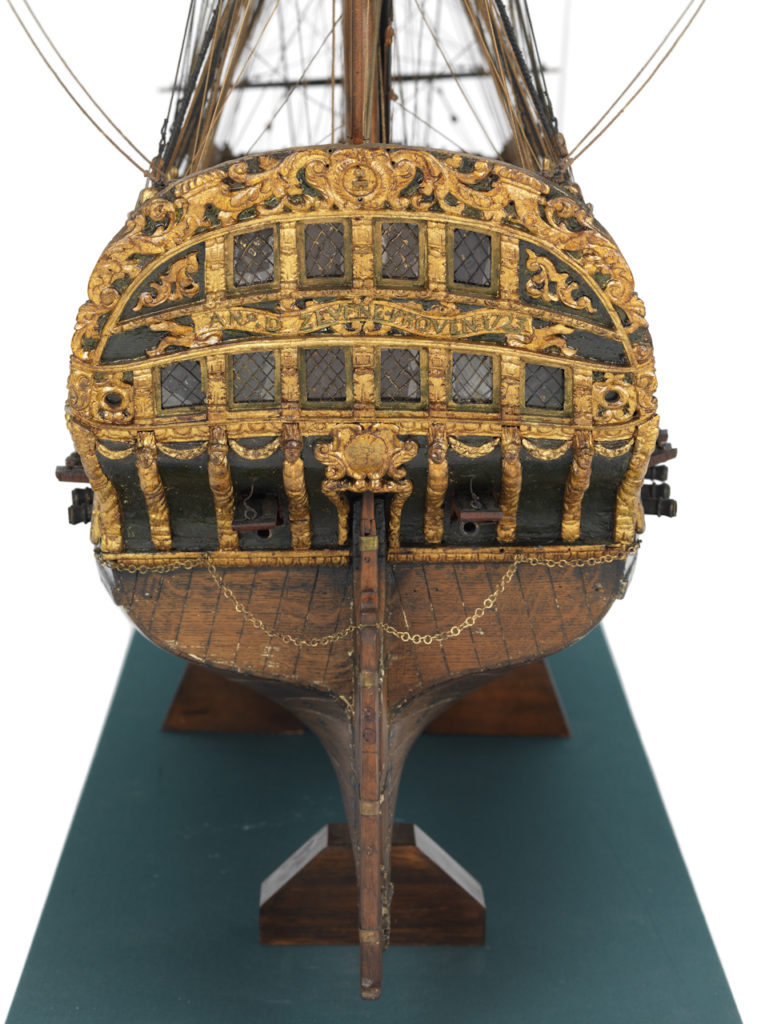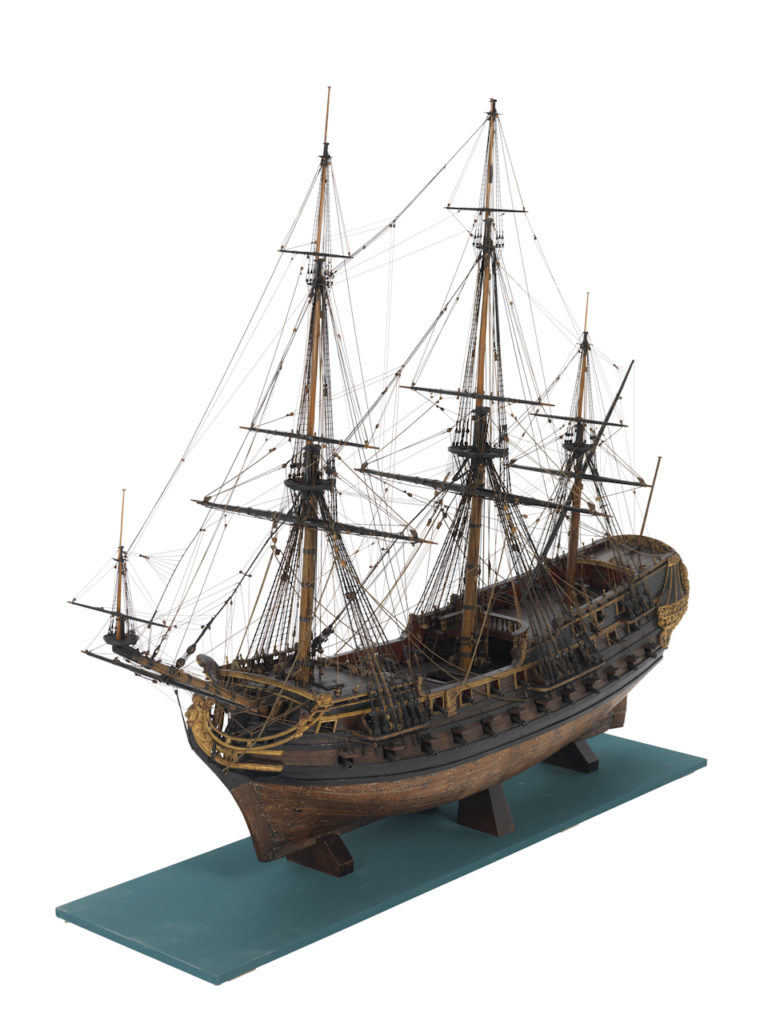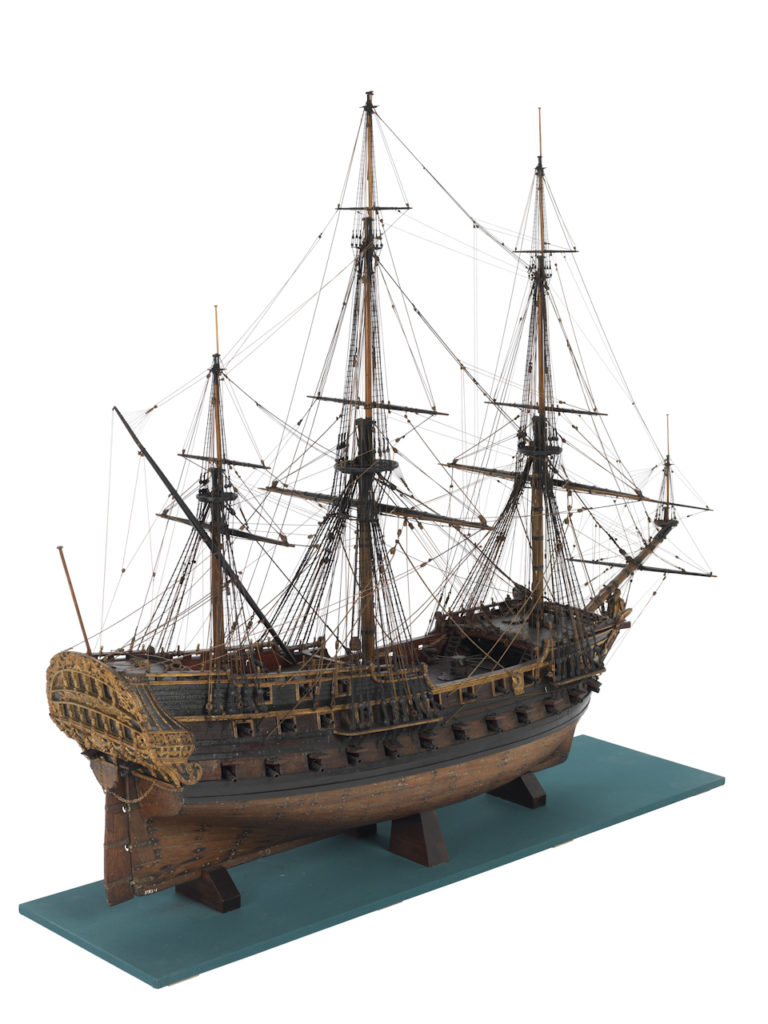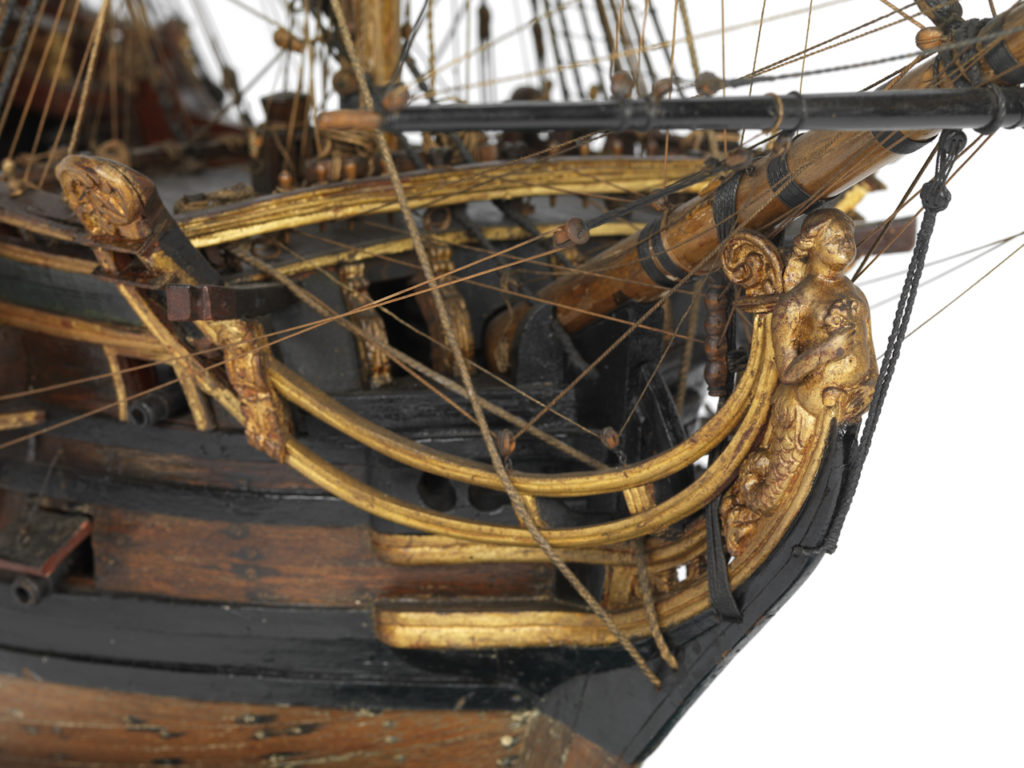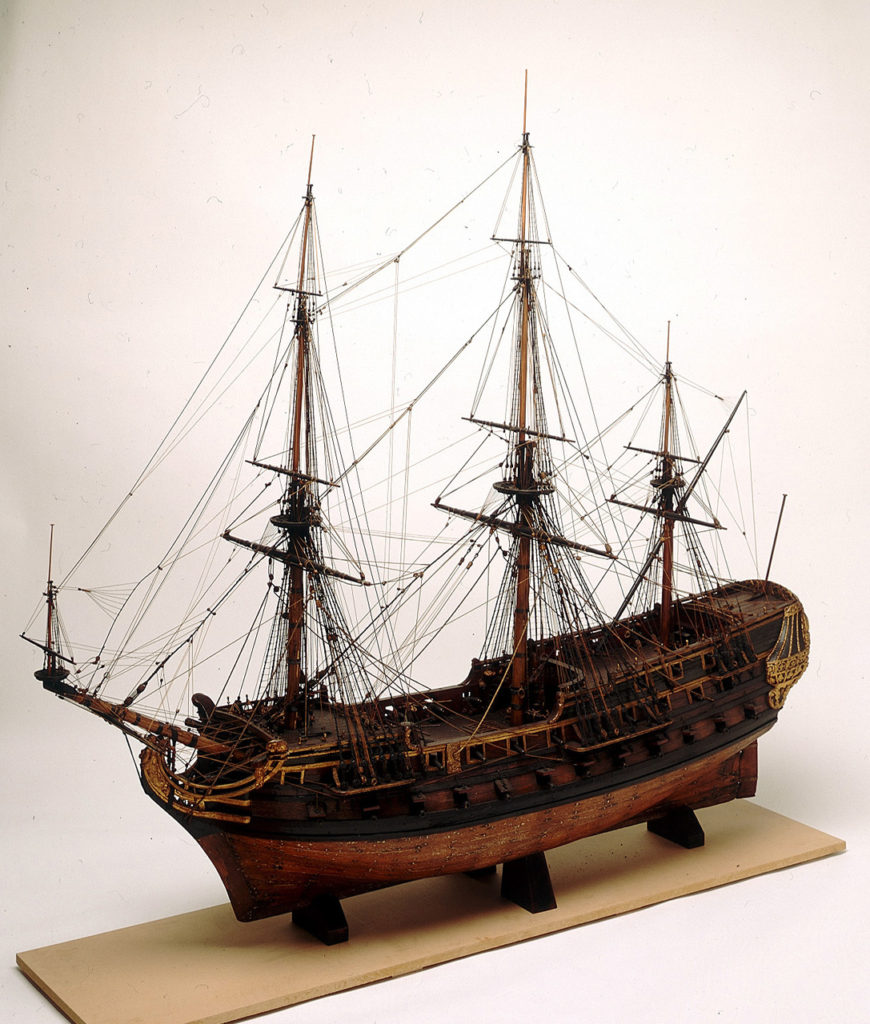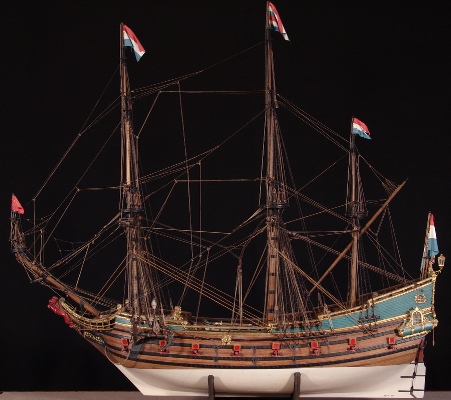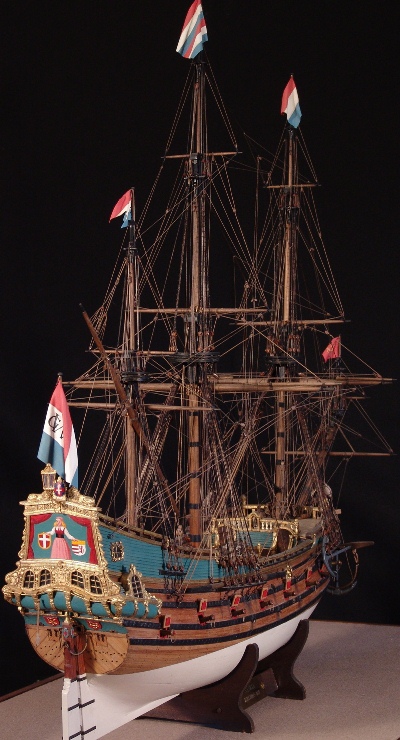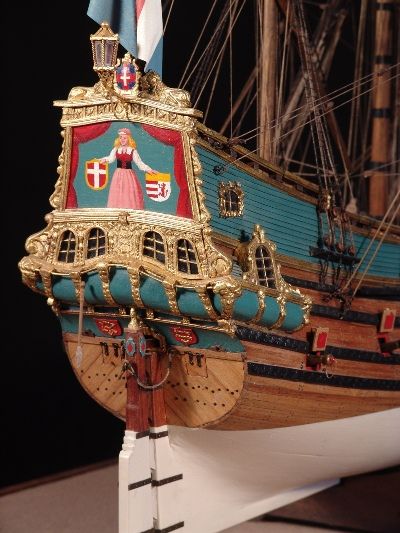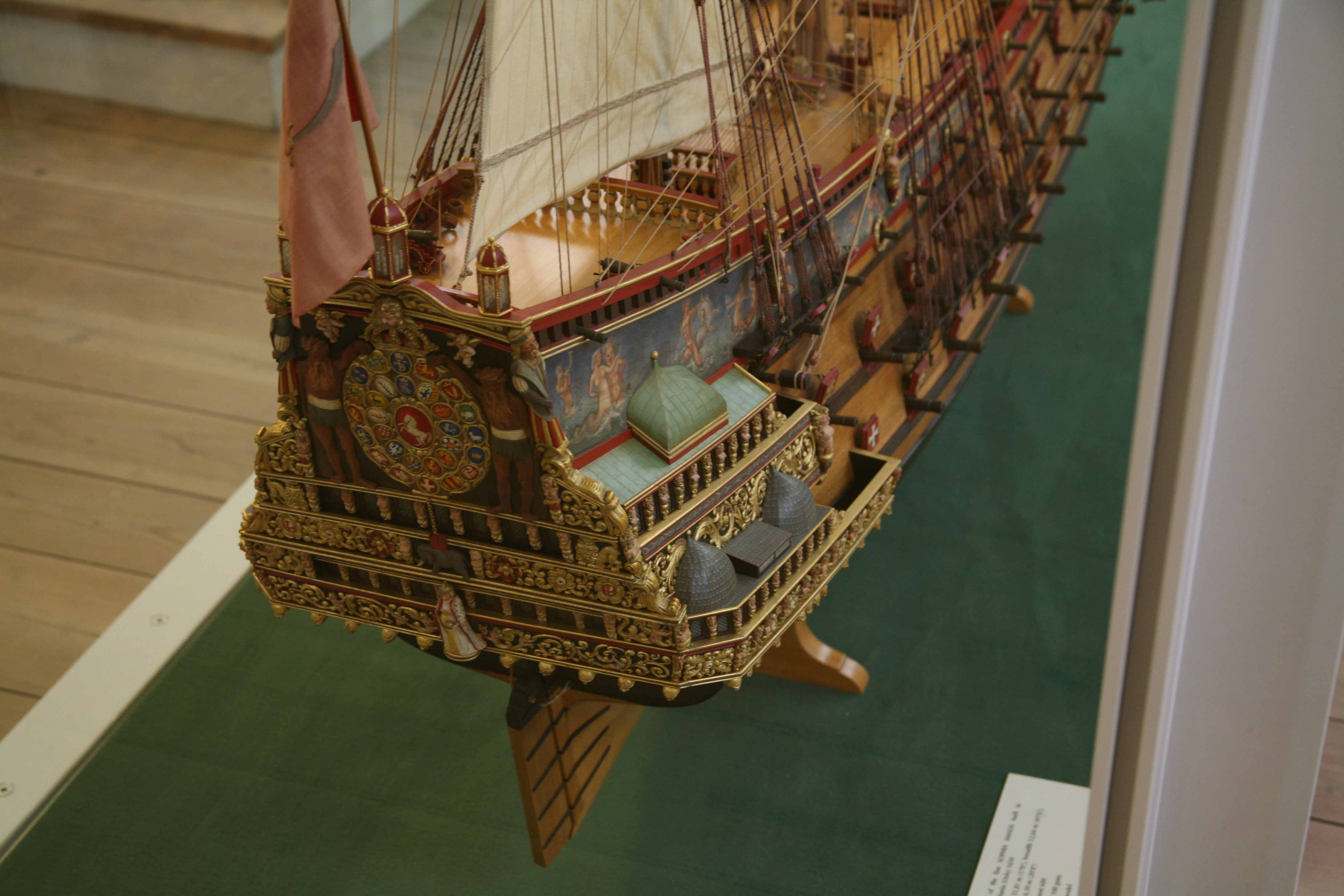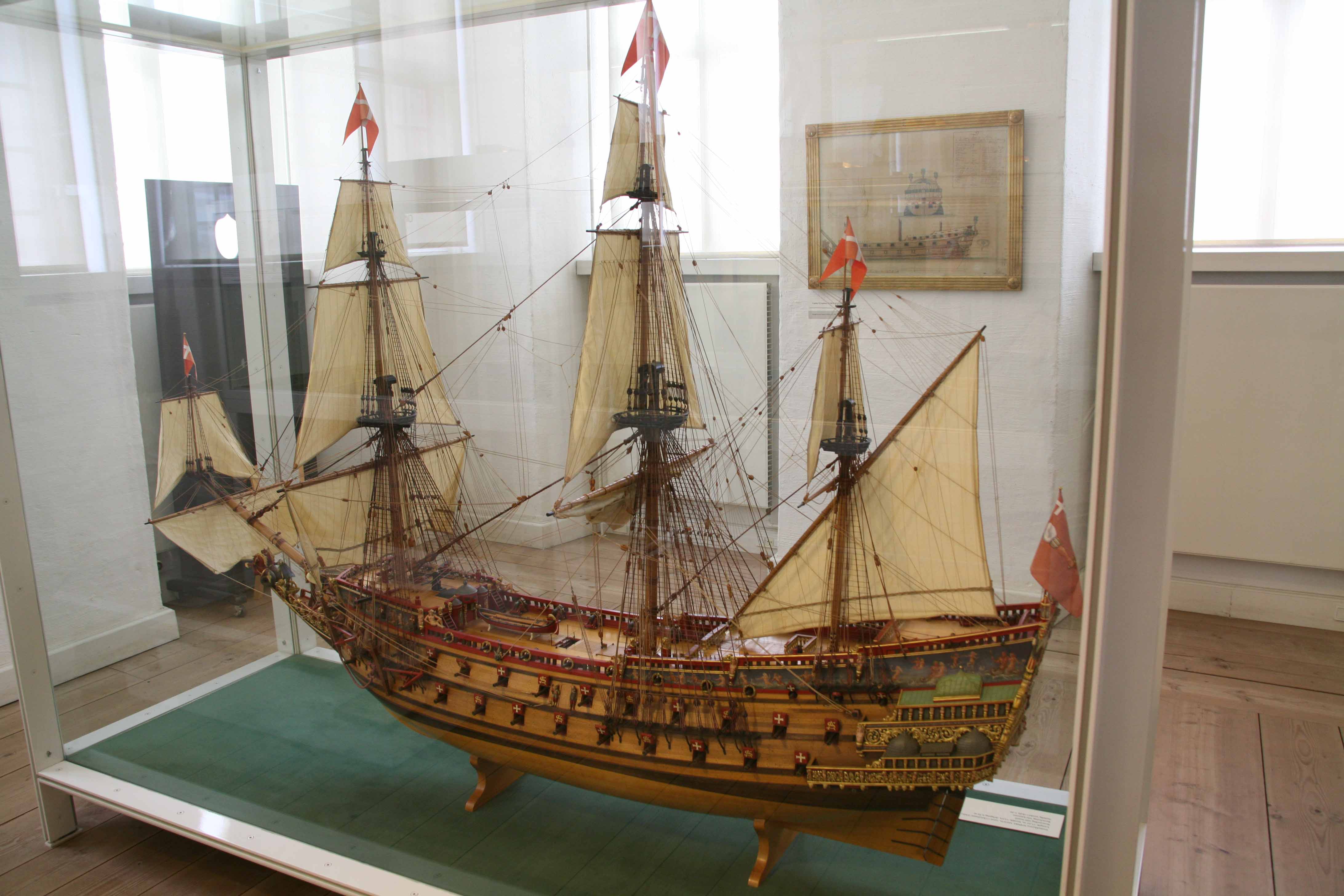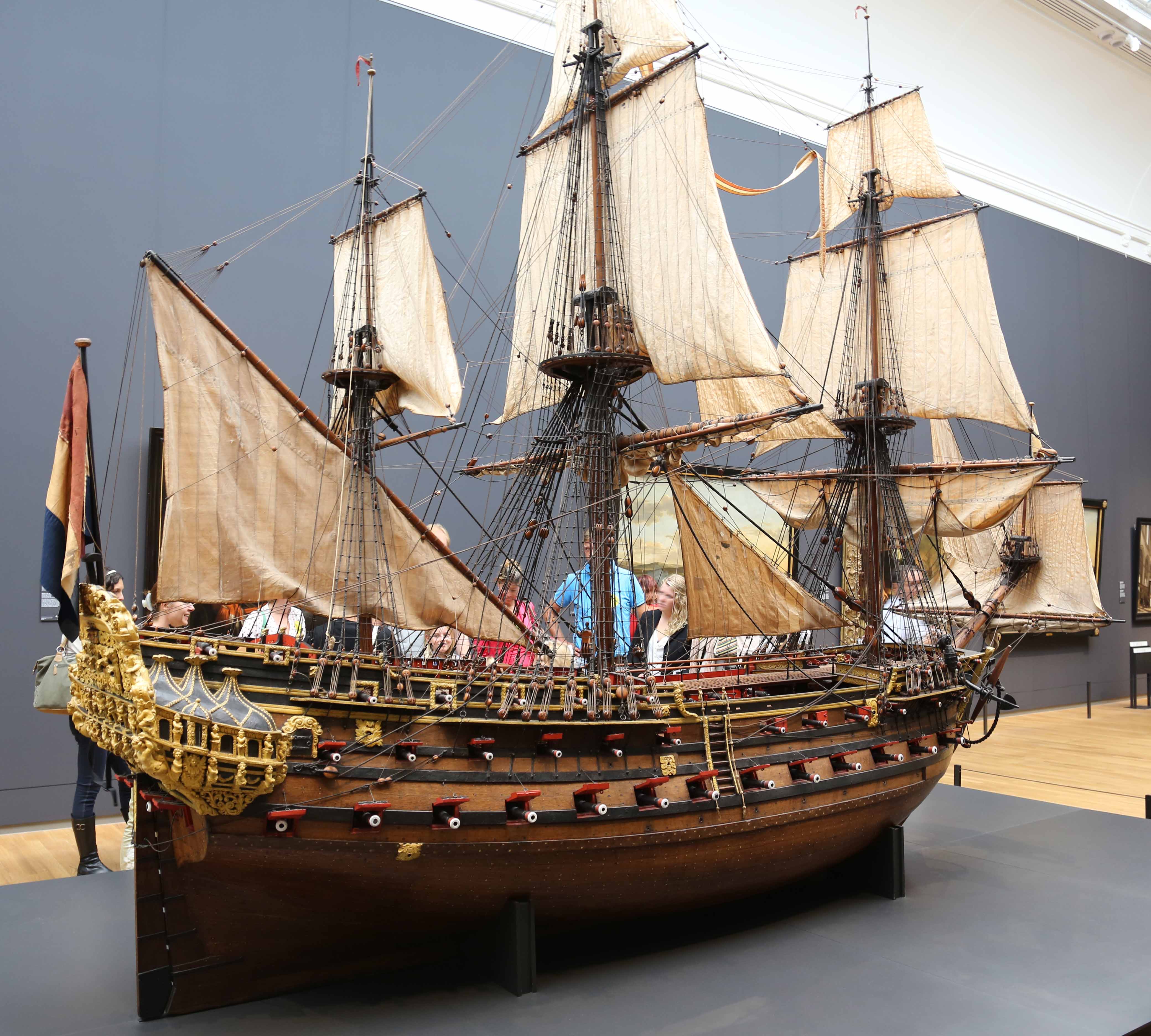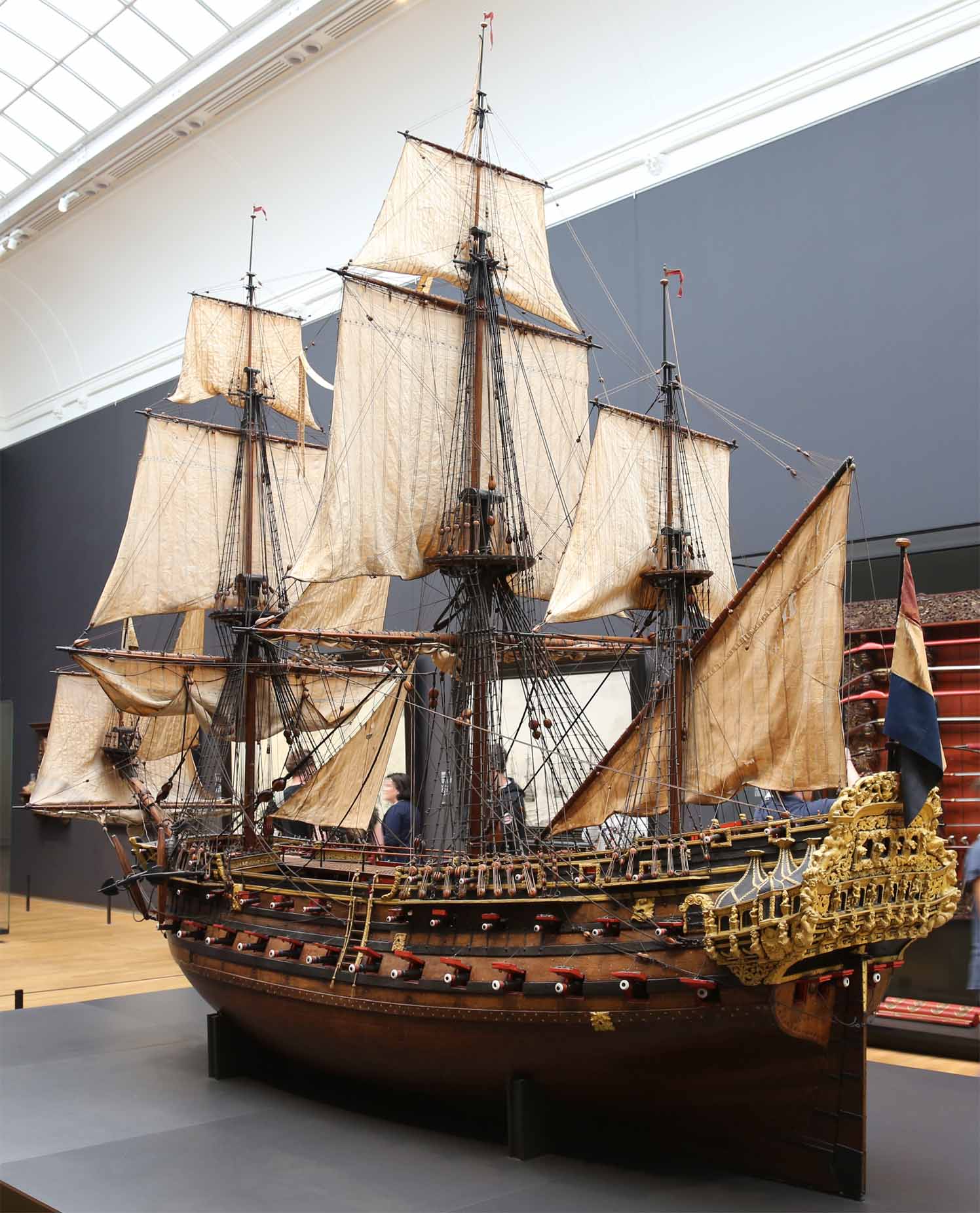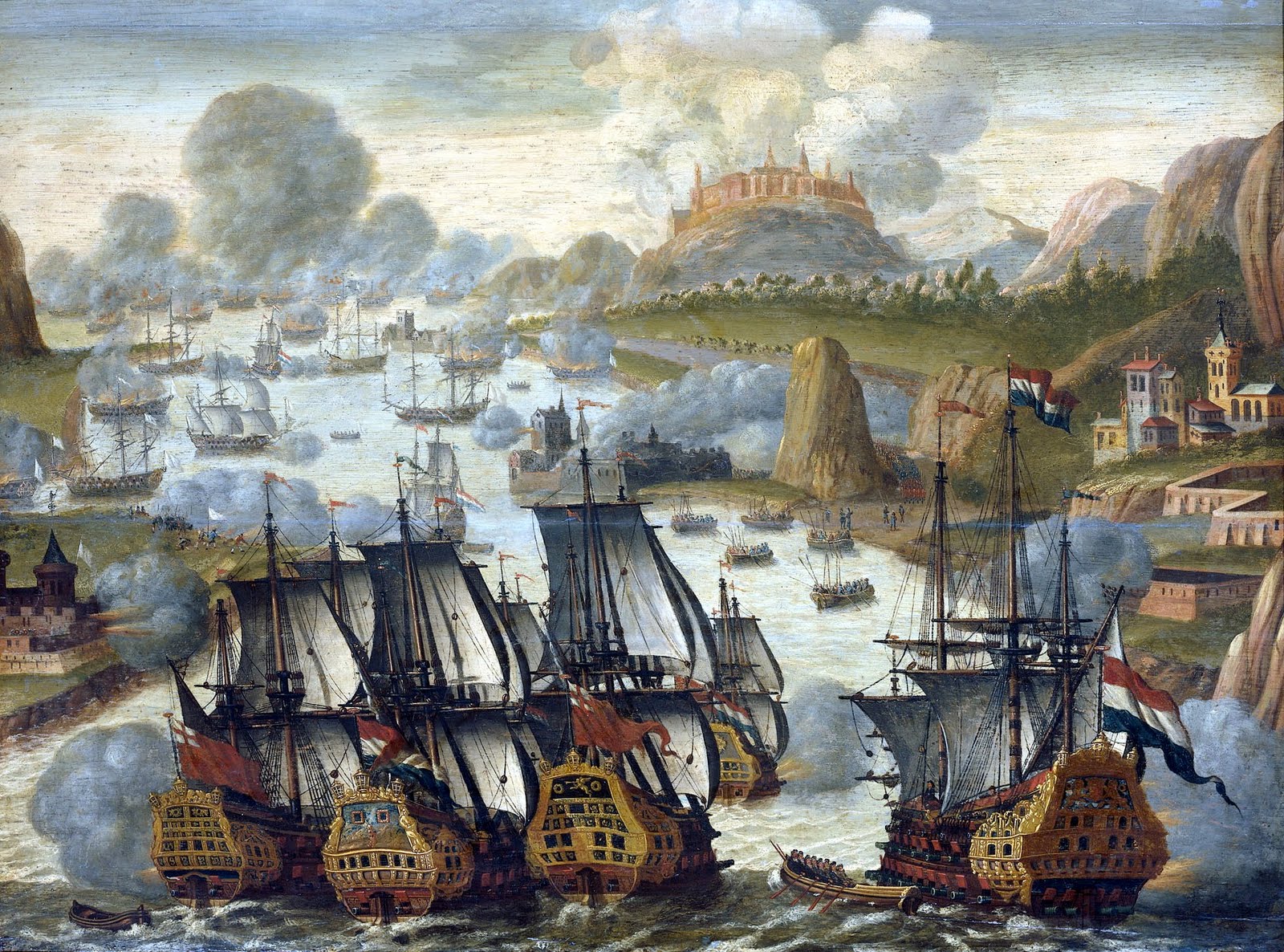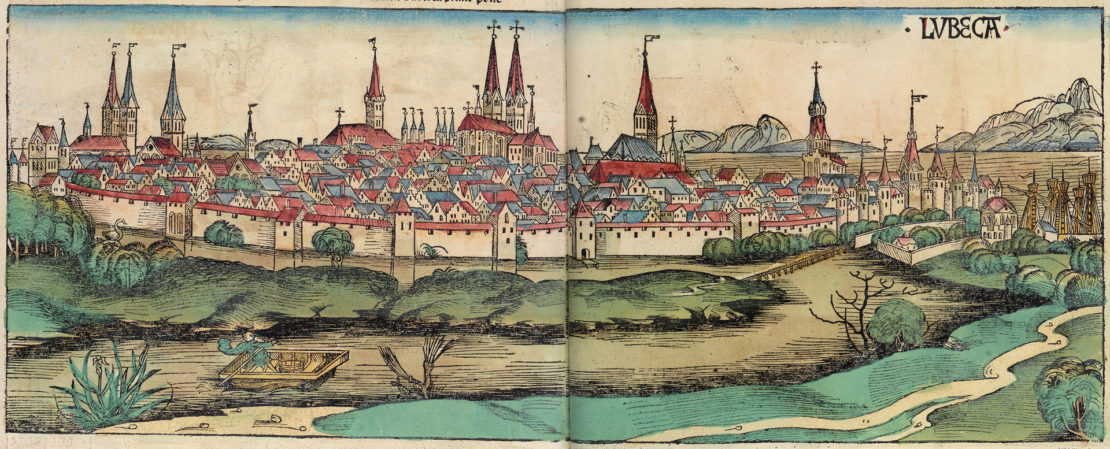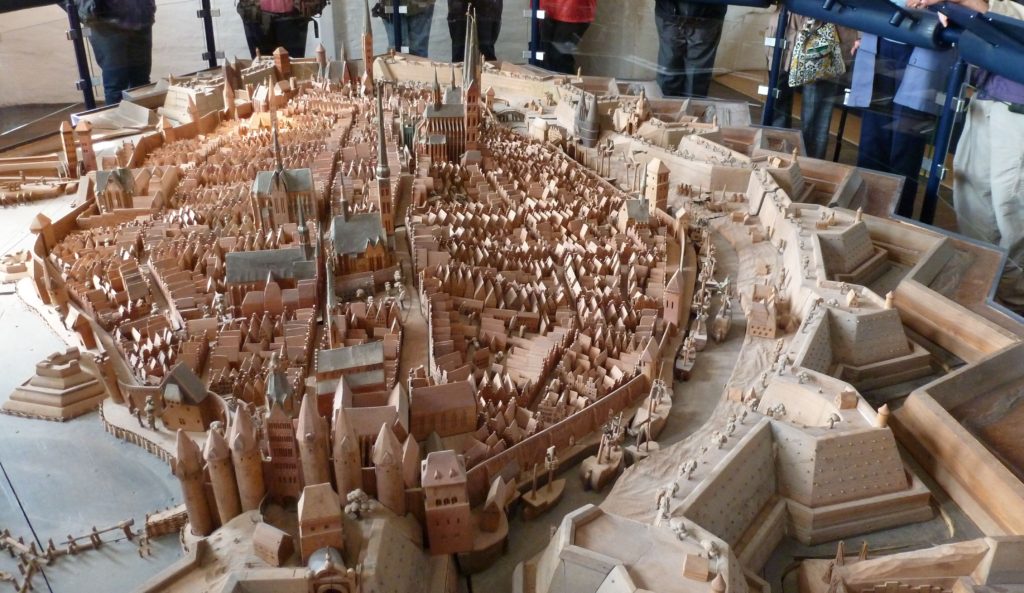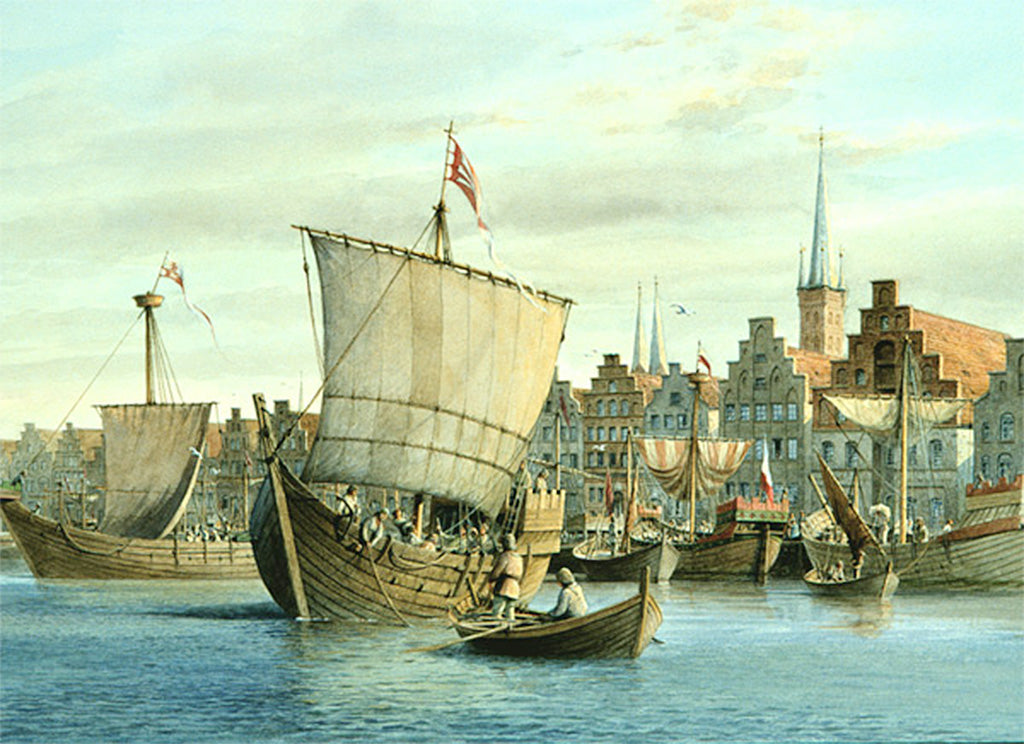Models of the Week
MODEL OF THE WEEK D Zevene Proven (Seventh Province) of 1723
19 September 2017
I thought it was about time I post something here again – especially considering all of the incredible models I’ve come across in the last couple years.
I have always been fascinated by ship evolution and development over time. This is a subject that is both incredibly and meticulously researched in certain time periods and practically ignored in others. Take the last quarter of the 18th century into the first quarter of the 19th – an era where very little can be added in research because of the mountainous volumes of literature on the subject for the last two centuries. I guess this is one of the reasons I find it somewhat boring. There is no doubt that maritime architects had honed their science and art to their apex and achieved efficiency and beauty captured in hundreds of sleek designs that are the epitome of simplicity.
I do not begrudge those who enjoy this era their favored subject of study, I just believe that they have become garden variety scholars in their discipline. I see this among historians constantly – a historian who is an expert on one single decade or war, and mostly ignorant of everything else before or after. To me one cannot be an expert in anything unless they understand the full context of the firmament that their favored area of study fits into.
My last decade in the military I became so sick of military officers who believed they had a little historical knowledge making fun of French military prowess. This has always been one of my pet peeves – something that sets me off so to speak. I knew I had fully matured when I would laugh off the comments and move along without a response, but knowing what sort of idiot I was dealing with. When I was younger, I would go into an Aspergers dissertation on French military history and achievement and how many of those key developments not only contributed to modern warfare as a whole, but also to our own military’s development and evolution.
I digress, but will say that my examination of Chapman has always been kind of a secondary (somewhat dry) pursuit/study when instead I could choose to peruse the many works including illustrations and commentary from Landstrom, Pett, Deane, Witsen, or Cornelius van Yk. I remember discovering Landstrom’s many illustrated works as a boy. I have them all now and most are out of print. I was overjoyed in reading them. Not only did Landstrom research the history of European exploration, he also paid particular attention to the ships. His landmark work “THE SHIP” is still one of my favorites to browse through.
I have used the illustrations and examples and his meticulous notes to find the original sources of the figures. There are so many of these that it could send one on the journey of a lifetime. Landstrom did such a wonderful job in this work of noting subtle changes in shape, form and architecture over time. However, he still missed quite a number of evolving developmental changes which I contend are both mentionable and significant. In my continually expanding manuscript on Piracy: A Story of European Expansion, I have dedicated an entire very lengthy chapter on ship evolution from the mid 16th through first quarter of the 18th century.
I trace the evolution of the sailing frigate much further back than most modern authorities do. I document the evolution of the galleon form into the 18th century as I gave a taste of in my recent Galleons for Dummies post.
One of the reasons I started our modeling contest here was in the hopes I could actually find people who want to be challenged by something different – not the usual easily obtainable late era plans (“low hanging fruit”), and tired ole Chapman. But only a handful have stepped up to show any interest. I am guessing that this may be due to Naval Action continuing to encourage all modelers to churn out easily managed garden variety models. Guess the pay out must be good. Oh well. We will keep going with our own and see what happens.
With all of the above in mind, I present to you a model of the Zevene Proven of 1723 which can be found (but not on current display) within the large NMM Greenwich UK collection. They have incorrectly labeled the ship the Zeven Provincien (or Seven Provinces). This name is particular to warships and what we have here is NOT a warship. The ship is from an antiquated Dutch notation that contemporaries of that time would have instantly recognized as Zeven(d)e Proven(z) (The Seventh Province). In other words, she was a trading ship – a Dutch East Indiaman from the 7th province of Groningen and Ommelande (yes the provinces had numbers assigned to them).
I find this ship simply fascinating in every way. The old retourschip design is now long gone and she is now a clearly recognizable “Indiaman” class ship. When she was built, the glorious age of piracy had less than a decade left before its end. YES she is indeed new when comparing her to her earlier galleon-esque sisters (many of which would have still been seen surviving and working the seas – sailing in and out of all of the world’s great ports during her own first decade at sea). She is lower, more simply decorated, her stern has been cut down and her lines are more modern, HOWEVER – just look at all of the earlier era’s influence and design cues in her construction.
Yes her decoration is less and arranged in the now popular wide rounded-top tafferel/taffrail. However, it is still much more significant than that found on ships just a decade later. Also note the gilding and sculptural forms – clearly more at home on her earlier sisters than upon her sisters yet to be built. In many ways she is the last of her kind in this respect. She also still has a “galleon-esque” flat tucked “notch back” stern instead of the rounded dove-tailed sterns popularly seen on other Indiamen built by other nations (French/English) at around this same time. While she may be lower and her stern cut down, she still has a noticeable difference in vertical height from her much lower waist in comparison to a significantly higher foc’sle, quarter-deck, and poop. One could almost get away with calling her a galleon and some architects would even argue that SHE IS.
Variety is the spice of life my friends. I would welcome such a ship in Eras. I bring you these awesome pictures for education and your consideration. I love vanilla. But I love Vanilla and Chocolate even more. What’s that? You say that Baskin Robbins has 84 flavors! Damn – I’m goin man – as long as no one messes everything up and mixes all the flavors up into ice cream slurry! MK
MODEL OF THE WEEK The Dutch Pinasschip
10 October 2015
Well I have run onto a bunch of great models in the last 6 months, but this one is my current favorite and I just happened on to her a couple days back. She is a gorgeous little Dutch pinnace that won the gold medal at the Nautical Research Guild in 2011. Here’s the link: Dutch Pinnace
…and here are the pictures. Enjoy. MK
MODEL OF THE WEEK The Anne
25 February 2015
A couple years ago I had the good fortune to explore the wonderful coasts of Georgia and I had a chance to stop in at Savannah for a couple of days to visit it’s historic charm. During this sojourn I was able to spend a couple of hours in their fine “Ships of the Sea” Maritime Museum. It’s always such a thrill for me to find one I didn’t know about or haven’t been to before – even if on the small side.
The Savannah Maritime Museum is a gem of historic models, fine art, and nautical artifacts that all tell the story of Savannah’s rich maritime heritage. Its housed in an old mansion, the Scarborough House, once belonging to the original owner of the first steamship Savannah. The price of entry is a little steep in my opinion, but there are numerous discounts, for military, senior, and AAA members.
I especially enjoyed their sampling of figureheads. There are some really nice examples here and I always study every detail and wonder at all the places they’ve been, seas they’ve spanned and the things they’ve seen when they were still attached to the prows of their long departed vessels. If you’re into clippers, then you need to take a look at the paintings in this place. There is an excellent collection of paintings by numerous artists of every shape and size of yankee clipper.
The artifacts and nautical displays are also quite good and tell the history of navigation. From astrolabes to hourglasses – octants and sextants, its all here. Also the museum boasts a really nice and fairly extensive ivory and scrimshaw display to include a really nice 18th century bone and ivory model brigantine.
Understandably, I most enjoyed the ship models. I am more favorable to the earlier eras of exploration and the Golden Age, so one model particularly held my fancy. The Anne is a large scale model of the first ship to bring settler’s to Savannah in 1732. She is an English merchantmen of about the 1710-20 timeframe and typical of English or Dutch Guineamen built at that time with only the weather-deck designed and rigged for armament. I love this ship with its clear 17th century influence still prevalent in her rake, lines and decoration. She is probably very close to what Blackbeard’s famous “Queen Anne’s Revenge” would have actually looked like before the pirate pierced the “slave/cargo deck” for twenty more guns acquired from other ships.
Her claim to fame is that she is the ship that brought the first colonists to the Savannah area in 1733. She was 200 tons, 87 feet long, and 26 feet at the beam. Here are some pictures. Unfortunately there was a lot of glare on the glass case around her. I did my best.
And a little more about the museum for those that are interested….
A late 18th century French ship of the line adorns the center of the main model room. She is typical of ships of this era and type. Several early steam era models are also in this room. All the models are in large glass cases which made it really difficult to get good pictures of anything with all the glare from the windows and lighting reflecting off of the glass. I only included the pictures that turned out decently. I had to delete dozens that just didn’t make the cut due to the lighting.
The house has a spacious central hall with a skylight above skirted by the banister railing of stairs and floor above. In this space is what I believe to be the museum’s largest and most impressive model. The mid 19th century model (pre-Civil War era) U.S. frigate Savannah – and she is a sight to behold. Her large guns are all proudly run out and she has the distinctive circular track fore and aft guns with crews at the ready. An excellent example of ship evolution into the modern era. The guns are pre Whitworth or Parrot, but I would wager could hold a six pound powder charge. I commented to an observer that they would have had 10 times the power of the large 36 pounders on the French Ship of the Line in the previous room.
Almost all of these impressive models were commissioned from the famous modeler Joseph Gallettini. However there is a very large and conspicuous model upstairs that was originally built for the British Admiralty in 1803. This model is of the HMS Shannon. I was at quite a loss when I saw her. I was not expecting to see this vintage of model there and wondered how she came to be in America and even more – in the South. At any rate she is there. For anyone modeling the Shannon, I recommend a visit. Most of my photos of her didn’t turn out so good. I did the best I could.
To my shock the time just zipped by and I barely had a chance to visit the book store and buy a few books and souvenirs before the museum closed. The staff were friendly and helpful and this place is clean, well maintained and has very easy access with excellent parking in the rear.
If you ever get down Georgia-way, I highly recommend a visit to this treasure of a museum. You won’t be disappointed. website: Ships of the Sea Museum
The complete set of Photos I took of the museum can be viewed HERE
MK
MODEL OF THE WEEK 108gun Sophia Amalia (1650)
01 February 2015
The beautiful ship of the line, Sophia Amalia was constructed for the Danish Navy under the English shipwright James Robbins at the Hovedøen dockyards in Christiania (Oslo) Norway in 1650. Traditionally a shipyard for merchant ships, only four warships were built there between 1646-1700. She was commissioned by King Christian IV specifically to surpass the great English ship HMS Sovereign of the Seas. It is VERY clear when you look at her that James Robbins seems to have almost copied the great Phineas Pett’s design for Sovereign of the Seas. They almost look like they could be sisters. The English and Pett influence is clearly evident. Upon her completion, she was largest ship built for Dano-Norwegian navy up to that time. She was 51.8 meters long and at that time one of the largest naval vessels in the world. She was named after the German Princess of Brunswick – Sophia Amalia, the wife of King Frederick III.
Originally her dimensions were 165 x 38-6 x 17-6 ft. , but she was rebuilt in 1673 (165 x 40-3 x 20 ft). Her displacement was c.2000-2200 tons. For armament Sophia Amalia carried 86-108 guns at different times of her career:(She originally mounted 108guns with twenty-eight 24pounders on her lower gun deck surpassing the Sovereign by eight guns at the time. She was lightened to 100 guns in 1662, but received 102 guns in her final refit in 1673. She was manned at different times in her career with 571 to 643 men.
During her career she took part in the numerous battles of the Second Northern War, the Dano-Swedish War of 1658-1660, and the Scanian War, however she is conspicuously missing from the line-up at the great Dutch-Danish victory over the Grand Swedish Fleet at the Battle of Oland(1676). I have not been able to find out why??? She would have been the largest ship there. Instead the 68gun Churprindsen is recorded as Admiral Niels Juel’s flagship and the 80gun Christianus V as Dutch Admiral Cornelis Tromp’s flagship. I know from a study of the battle that there had been a lot of bad weather preceding, so perhaps part of the fleet fell behind? Sofia Amalia was finally condemned and broken up in 1687.
This beautiful model of this great and powerful warship currently resides in the Danish Maritime Museum in Copenhagen, Denmark. Royal Danish Naval Museum
Here are a bunch of great pics on an excellent German model ship site I often visit: Pictures of ship model Sophia Amalia
Isn’t she lovely! I love the Seahorse on the figurehead on this one. I have assembled a large amount of photos for her. I even have some Van de Velde drawings of her which is fascinating to me because it causes me to ask the questions. Did Van de Velde do the drawings in Denmark? Did he accompany the fleet there as he so often did? Or did the ship come to Holland on a state visit. I think not. I do not think her deep draft would have allowed her to make it to any of the Dutch cities unless she was cradled. I very much doubt they would have gone to the trouble plus it would be a little demeaning for a great warship. I think they must have cradled the Royal Charles when they brought her back to Amsterdam as a war trophy. Intriguing to think about nonetheless! I will be posting this great new collection to my ship images repository on Flickr in the next day.
MK
MODEL OF THE WEEK: 15 January 2015
WILLIAM REX (1698): Dutch 72gunner
Today’s model is of the 72gun William Rex. I first saw this model in 1993 at the The National Maritime Museum (Het Scheepvaart Musuem) in Amsterdam Netherlands Ship Museum I took many pictures and lots of video of ALL the ships in the museum over numerous visits that year and the next year. This model is not my favorite. In fact it’s not even in my top ten in that particular museum. However, it is a beautiful model of particular interest and it is just bloody HUGE. Most of the really impressive models in that museum are examples from the 1650s through the 1670s. This model however was built in 1698 in Flushing(Vlissingen) and is a replica of a real warship laid down in those very dockyards.
She is a beautiful example of a large Dutch Man O War built during the period of the War of the Spanish Succession – the last war of the Golden Age bringing in the 18th century with a tremendous bang. The war lasted 13 years and a conflict of its scale would not come again during the 18th century until its end with the Napoleonic Wars.
We don’t know much about the William Rex’s career. I could find hardly anything out about it. I’m sure there is a Dutch source somewhere never translated into English. This is a fascinating period though with a Dutch King sitting on the throne of England and all operations between English and Dutch fleets being mounted with duel command and combined fleets. I have a picture of the Battle of Vigo Bay 1702 which shows the combined Anglo-Dutch Allied fleet bottling up the Spanish Treasure Fleet which was protected by a French escort fleet composed mostly of large French ships of the line. Even though most of the treasure was offloaded, the Allies were able to destroy the combined Franco-Spanish fleet.
What I find really compelling about this painting is that the large Dutch manowar on the right looks an awful lot like the William Rex. Dutch ships were rarely built with above 80 or 90 guns because they had shallower drafts to accommodate the many shallow areas on the approaches to most Dutch cities. Notice also how different the transom or tafferel/taffrail decoration is than earlier in the 17th century. Ships of the Anglo-Dutch war and Franco-Dutch war era usually only had a single gallery of windows with decoration above which often identified the ship itself giving clues of where it was from by paintings of its town of origin or carved and gilded coats of arms.
Here we see two full galleries of windows and not so much decoration above. This mirrors the French and English practice. The Dutch had built ships with two galleries previous but most were for export to France and Spain. Now they copy everyone else and get with the times instead of building ships their own way. I find this kind of sad especially because the following decades saw a dramatic even drastic drop in Dutch naval power at the same time Britain began to dramatically expand and “rule the waves”.
The William Rex no longer sits in the Maritime museum. She was moved to the Rijkmuseum a short distance away. Rijksmueum
She actually caught my eye this last week because of some pictures I ran into online and a REALLY cool video of her restoration not too long ago. Take a look:
And here is the site I was telling you about. William Rex Model
ENJOY!
MK
MODEL OF THE WEEK
28 December 2014
Pictures of the Nuestra Senora de la Concepcion
This is the massive Nuestra Senora de la Concepcion y de las Animas. This fine model is housed in the Naval Museum of Madrid. She was originally built in 1682 and mounted 90 guns. I special ordered a book (in Spanish) on her description with good plans which I plan to upload and share. I eventually would like to build her either 3D or as a scratch built wood model. I will do more on her as a feature as I peruse the Spanish (which I am still learning) to learn her history. I know she survived until 1705 but haven’t figured out what actions/battles she was involved in. Obviously she was one of the largest Spanish Warships of the day. I find it amusing that people focus on the San Felipe when I personally find the Concepcion far more attractive.
Video of the Naval Museum of Madrid
MK
Error: Contact form not found.
Posted in Books, Historical Sailing ships, Model Sailing Ships, Museums and tagged Model Ships by modernknight1 with comments disabled.
VOTIVE MODELS: What’s a Votive Model? A Journey of Remembrance
In 1996 I knew my days in Europe and Germany were numbered. I knew we were deploying (for many months) to the training centers very soon to ready ourselves for a large scale deployment to Bosnia. In addition to being a M109A2 Howitzer Platoon Leader I was also the partnership officer for my Battalion and the Movement Control Officer for the 2nd Brigade, 1st Armored Division “Old Ironsides”. I wasn’t fluent in German yet but I was close. My conjugation was still off and I would substitute a quick sloppy “eh” on the endings of words when I didn’t know if an “er” was appropriate or not.
However, I was the best they had as very few Americans spoke any German at all. I had been the partnership officer in my last unit in Fulda (1st Squadron, 11th Armored Cavalry Regiment (ACR)) and now I was tagged again. It wasn’t because of any other particular ability but that I could speak the language fairly well. I was confident in my abilities to get around Germany and Austria after five years living there. I had been complemented many times by Germans who told me they didn’t even realize I was an American.
I was actually scared. I was a senior 1st Lieutenant with a LOT of experience. I was due to make Captain in a few more months and this was actually my third platoon – most young officers only ever got one. I was scared because I had already been in some training exercises with a bunch of young Germans in a place called Hammelburg. We were attempting to train them on rooting through urban areas trying to find the bad guys while rescuing the innocent women and children.
The Germans didn’t play – during almost every exercise STX lane, at the drop of a hat, they would open fire on the poor woman holding a baby every time. They just had never been trained to hold back. I would learn in a very personal way a couple of months later that sometimes it is better to shoot first and ask questions later.
I was scared that I was responsible for coordinating the movement of so much heavy military equipment so far away. It was a huge amount of responsibility for someone so young. I look at my own sons now and I can’t believe that I was their age when I carried upon my shoulders some of the heaviest responsibilities of my career.
In addition we had been briefed and taught how to deal with millions of mines that we were told we would encounter when we got into country. Despite all of this I knew I had a few more weeks before my life would change forever. I had a tiny little window of freedom left. I had dragged my family all over Europe when I took leave. We had gone everywhere. Just the year before, my best friend had come over from the States and we explored dozens of ruins and castles, hiked into the Alps and visited Italy. My unit leadership had felt guilty because I had been in the field so much and gave me 45 days leave all in one pop. I made the best of it.
My young kids were so great on these trips. They were always so well behaved in museums and sacred sites. We visited castle after castle and cathedral after cathedral – ruin after ruin – as a family.
This time however, I needed to go alone. First of all, my funds were limited and its expensive to travel with an entire family. Second my time was limited. I only had a few days of leave this time in conjunction with a weekend. My wife understood. She knew my love of history and she also knew she didn’t feel up to the whirlwind trip I was planning – especially after the others we had just finished a month before.
We had a giant map in the Kitchen hallway and me and the kids would put colored pins in it to show off all of the places we had been. The middle of Europe was really filling up with pins. We had been all over France, Belgium, the Netherlands, Germany, Switzerland, Italy, Austria, the Czech Republic and Poland.
I knew this would be the last chance I had to see some things I had always wanted to see. I had studied the famous King and General – Frederick the Great for years and he was one of my favorite generals. I had the opportunity at one point to read an original version written in French of his guide on tactics published for his own staff officers to read.
I remember I was so completely shocked when I found it gathering dust on an out of the way shelf in the military archival library at Headquarters, Building 6, Fort Benning, Georgia. A frail thin little book from the 18th century just sitting there on the shelf – not a copy or reprint! I thought about just taking it. No one would have ever missed it. But I am not a thief and I took my responsibilities as a young officer to never “lie, cheat, or steal” very seriously.
After I had devoured it myself, I went to the chief librarian and complained. I told him that this was something that should not just be sitting on the shelf for anyone to take. It was a piece of history and it should be preserved or at the very least put in some special protected reference section. He took it, looked it over and agreed. If I HAD been a thief I think I could have been a rich man with a pamphlet so rare. Wonder how much it would fetch at auction.
I’ve always liked the underdogs and my admiration for Frederick was so great (Stonewall Jackson’s inspiration for “Foot Cavalry”), that I had always wanted to visit some of the battlefields in Silesia he had fought upon – but more importantly I wanted to visit his refuge Sans Soucci (Without Care). I was also a great admirer of Gustavus Adolphus and I had never visited the great old battlefields at Lutzen OR Luethen. I had also never visited Wittenburg and wanted to see the church door where the 95 Thesis was nailed, sparking the bloodiest two hundred and fifty year period in history – the Reformation. I also wanted to see the cities of the Hanseatic League. So I was absolutely determined to get to northern Germany while I had the chance.
So in a little less than a weeks time with me sometimes spending the night in farmers fields setting against (or on) old battlefields, I was able to walk the ground at first light of these great bloody places and imagine the carnage. One night I swear I heard the ghosts of the past on the old Napoleonic battlefield outside of Leipzig. I saw Wittenburg, Potsdam, San Soucci/Charlottenburg, Berlin, Bremen, Lubeck and Hamburg.
Sans Souci was wonderful. It was like going into a fantasy land almost frozen in time. At one end of an extremely large square expanse of paths and gardens was the huge Charlottenburg palace – at the other end opposite a pretty little baroque palace on a hill with a dozen or more French doors. It was charming (Sans Souci). In between and along the borders of the gardens were wonderful overgrown faux Roman ruins replete with water features, an aqueduct, etc. – there was a little fake Carolingian monastery and an old Roman villa. I expected to see a white rabbit somewhere in between and I virtually had the whole place to myself. I encountered a small hand full of visitors at Charlottenburg, but that was it.



Potsdam was awesome. I felt like I had found a giant piece of old Amsterdam or some place in Holland just plucked right out of the earth and plopped down in Northern Germany. In fact they call that part the Dutch Quarter. It’s a really cool old historic town with an immense amount of history to uncover. I was so sad I didn’t have more time to explore. I did a quick drive through of Berlin as well. I stopped at the Brandenburg Gate and then headed to what was left of the Berlin Wall. It hadn’t been that long since it had come down, but there were only a dozen or less concrete slabs left – and they were covered in colorful spray painted graffiti. I managed to chip off a small piece as a souvenir when no one was watching. I looked down into a giant pit that seemed to go on for miles in either direction where the wall had been. Massive construction was going on. I had no idea there was so much underneath it.
/about/146378397-56a3ad643df78cf7727e8e30.jpg)


Lubeck however, impressed me more than any other place on this trip. It was amazing – and here is where I spent the most time. I was just spell bound. It was the former capital of the great Hanseatic League – the hegemonic trading and banking confederation of free cities that dominated trade before the rise of the Netherlands. In the museum I poured over a huge old wooden model of Lubeck from the 1400s. I was MORE than impressed. This was one of the most fortified cities I had ever seen – and I had walked the perimeters of many of these places and seen many more in old illustrations.
Lubeck had to be fortified given its wealth and the turbulent violence often occuring around it. The German Emperor had given it “Free City” status. Lubeck became the kingpin city in the confederation of rich trading cities known as the Hanseatic League. These were the richest cities in the world at the time. These were great maritime cities with fortified harbors. All the goods of Northern Europe and beyond flowed out of these great cities that went as far as the Low Countries.
….and here is where I discovered the subject of this piece – VOTIVE MODELS. Being a great old maritime city with many great ships in its past I should have expected to see something of this history displayed. I had seen ship models in the museums and was impressed, but I had no idea that this past would still be preserved so well in other places. I hadn’t even gone into the church yet when I wandered into an old pub in Lubeck to get something to drink.


There hanging from the high wide ceiling beams of the ancient beer hall were ship models – all over the place. I was spellbound and began to take pictures. I hadn’t seen anything like that in the Dutch pubs although I had seen a few models in the Dutch churches.
When I went to the surrounding churches and cathedrals, it was the same thing – wonderful very old ship models hanging from the ceilings. More pictures were in order. In the Lubeck Cathedral I also found a really neat old rendering of the “Totentanz” Dance with Death. This so inspired me that I began researching this old subject and started putting a book together about the renderings – yet another I have yet to publish and I have so much good material I’ve collected. I even captured the little poems in my story about Piet Heyn. The old Grave digger recites a poem about the dance with death. I made this poem up completely on my own but it reflects the meaning of the non-English ones I have found.

So these votive models are usually a phenomena you will encounter in Northern Europe but I understand some places in Spain, France and the UK also have them. They are amazing and they are of every quality – from rough almost folk art pieces to exacting replicas with every detail. One can really learn a lot about the ships of those times simply from studying the models. I wished I could get up on ladders and look down at the ships decks and see them up close. No such luck but there are so many images of them on the internet now that many excellent examples can now be seen.
The Wikipedia page on them says they are confined to churches, but doesn’t consider they are also found in pubs as well. Also it doesn’t say WHY they were made. I have not found anything to back up my suspicions here, but I will make a historical hypothesis and say that seamen gave them to churches as representations of actual real ships so that blessings and prayers could be said – both for ships on journeys and in danger – and also as memorials of remembrance for the souls lost on ships that never made it home. Here’s what Wikipedia has to say on the matter. https://en.wikipedia.org/wiki/Votive_ship
So I will get to the meat of the matter now and allow you to feast your eyes on some of the awesome photos of votive models I’ve found. Unfortunately I’ve never been able to find the pictures I took back in 96. This was before the age of digital cameras where you still had to take film into the store to be developed. I have a couple of large boxes full of nothing but old photos from my travels – one of these days I will go through them. Here’s some images of Votive Models:



Look at this one. Blood flag on the tafferel and Lion of Holland on the mainmast. COOL!




Another Dutch one from Alkmaar Cathedral. Check out that Blood Flag!
























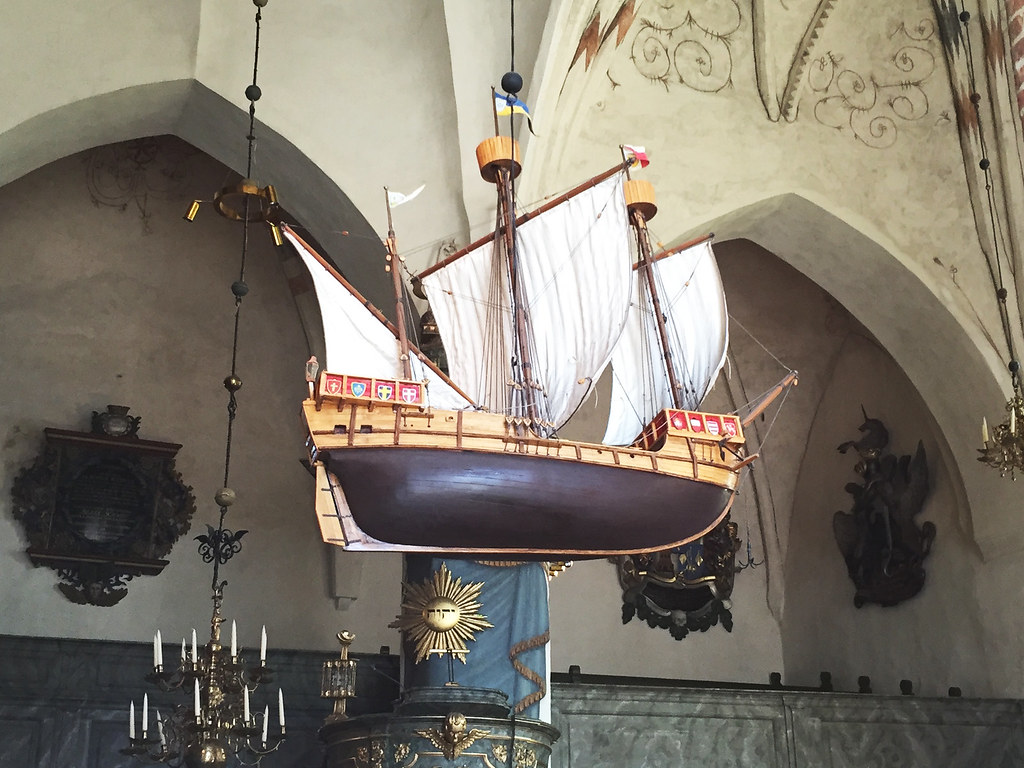
Really neat eh?!
I wonder how many of you had never seen or heard of these models.
Anyway, my trip back was uneventful, just stopping to take meals. I remember thinking on my way back how much I was going to miss my trips driving in Europe and I was right. Bosnia was a disaster for my outfit. I did a great job getting our equipment down to Pecs Hungary, but the rivers were so swollen we couldn’t do anything. The bridges were quite literally medieval and so we started to build our own. Initially one of the generals got the bright idea of trying to cross the Sava river using the fording kits on the Bradley fighting vehicles. That was a disaster. Damn things flipped over in the drink and drowned a bunch of poor guys.

Once we got in we had no tank support because the roads couldn’t handle them and everything was water-logged. I felt so guilty because I had orders to leave to go back to my advanced course since I was being promoted to Captain. Just as all the fun was beginning with mines blowing off guys legs and snipers shooting friends I had known a long time, I got direct permission from the General that I could leave. He reminded me before I left that he could F**k me if he wanted to and make me stay – but that I had been a “good guy” so he was gonna let me leave….. and back I came.

After I got back I was told that a lot of bad things happened in my outfit. My partner in crime through thick and thin – a senior black Sergeant First Class, went nuts after I had left. We called our chiefs of Firing batteries – “Chief of Smoke” or “Smoke for short”. Most of the men would address him that way because it was like a title.
A conversation might go, “What the hell you think your doin son? That .50 is not correctly oriented to the sector on your range card? Do you require some remedial training soldier?” response, “No smoke, sorry smoke (pointing the weapon onto the sector correctly), I got it!”
Me and him were the perfect team. We knew what one another was thinking and had the highest regard and respect for one another. His nick name back home on the block was “Junebug” and mine had been “Rock”. When we knew the men couldn’t hear us, I would call him Junebug and he would call me Rock. “what’s up Junebug?” “Oh nuttin much Rock.” One of the funniest things I ever heard was from him – he had a great sense of humor.
In the Army we have an old saying that whenever you’re tired in the morning or just can’t get going, it’s called “draggin ass”. One morning I saw he hadn’t gone out to check the gun line yet and it was almost light. I came up to his hummer and asked him “what’s up Junebug, why haven’t you gone out to the line yet?” He replied, “Sir, I got the Chinese disease this morning.” I chuckled not knowin what the hell he was talking about. “What the hell’s the Chinese disease Smoke?” He smiled and paused for a second and then said “You know, the Chinese disease – I got THE DRAGONASS cause I’m draggin ass!” Took me a second to put the joke together with the whole oriental dragon business, but I got it and laughed my ass off. I’ve used that joke ever since.
Junebug was found miles away at some lake. He was lucky he didn’t get his leg blown off because plenty of other men had with all of the mines everywhere. They found him fishing with a pole he had made himself and a bottle of Wild Turkey – how he got the hooch I will never know. Maybe he had brought it with him from Baumholder and kept it squirreled away for a special occasion. I heard they busted him and sent him back to the states. I should have volunteered to stay. I’ve always wondered what happened to him after that.
I’ve been back to Europe many times since then, but only for a few weeks at a time and mostly for work. It’s never had the same magic it did back when I was that young inspired leader of men. I thought I could do anything. Boy was I ever wrong.
I have found myself at times day dreaming about driving that old slightly beat up black 1987 Mercury Lynx 5 speed manual that I had bought for $600 dollars from a young soldier (a mechanic) who had worked for me and had orders to return to the US. That car was awesome – it ran perfect. I remember one time I got a flat tire in the middle of Austria and pulled off into what looked like a rest area. It was a historic site. No one was there. The signs pointed to this rock that was elevated above the ground on a little mound facing the road. The rock was not carved really. It had a sort of weird natural shape of a huge chair.
It was called the Königsthron and the explanation was that way – WAY back – German tribal chieftains would gather there and their highest leader would preside over a council of warriors and chieftains there. I sat in the seat and imagined. No one else was there. I thought to myself that a German tribal war chieftain from the dark ages or pre Christian era Sutton Hoo culture would never have been able to imagine the road that now ran in front of the old stone seat and would really never have been able to imagine my crappy old Mercury Lynx. I chuckled to myself imagining that I was the war chieftain – and then I walked back to my jalope and changed the tire.
I wish I were back on the autobahn in 1992 right now.
MK
Posted in Historical Sailing ships, Model Sailing Ships by modernknight1 with 2 comments.
